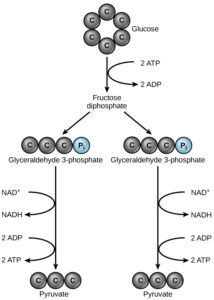46 Aerobic Respiration: Glycolysis
You have read that nearly all of the energy used by living things comes to them in the bonds of the sugar, glucose. Glycolysis is the first step in the breakdown of glucose to extract energy for cell metabolism. Many living organisms carry out glycolysis as part of their metabolism. Glycolysis takes place in the cytoplasm of most prokaryotic and all eukaryotic cells. That means that even though we think of the mitochondria as being the part of the cell where energy (ATP) is generated, that’s not 100% true – some ATP is generated in the cytoplasm! Since prokaryotic cells do not have mitochondria (or any other membrane-bound organelles), that makes sense. They still need to be able to generate ATP, so that must be possible without the use of a mitochondria.
Glycolysis begins with a molecule of glucose (C6H12O6). Various enzymes are used to break glucose down into two molecules of pyruvate (basically a glucose molecule broken in half). This process releases a small amount of energy.
Glycolysis consists of two distinct phases. In the first part of the glycolysis pathway, energy is used to make adjustments so that the six-carbon sugar molecule can be split evenly into two three-carbon pyruvate molecules. In the second part of glycolysis, ATP and nicotinamide-adenine dinucleotide (NADH) are produced (Figure 1).
The products of glycolysis include:
- 2 molecules of pyruvate, a 3-carbon molecule.
- A net gain of 2 molecules of ATP (4 molecules are produced, but 2 are required, so only 2 are actually gained by the cell (Figure 1)).
- 2 molecules of NADH, an electron carrier.
If the cell cannot catabolize the pyruvate molecules further, it will harvest only two ATP molecules from one molecule of glucose. For example, mature mammalian red blood cells are only capable of glycolysis, which is their sole source of ATP. If glycolysis is interrupted, these cells would eventually die.
Glycolysis does not require oxygen and occurs during both aerobic and anaerobic respiration. If there is oxygen available, aerobic respiration can occur and the pyruvate molecules produced at the end of glycolysis will be transported to the mitochondria to enter the citric acid cycle. If there is not oxygen available, the cell must do anaerobic respiration (fermentation), so the citric acid cycle and oxidative phosphorylation will not occur.

References
Unless otherwise noted, images on this page are licensed under CC-BY 4.0 by OpenStax.
Text adapted from: OpenStax, Concepts of Biology. OpenStax CNX. May 18, 2016 http://cnx.org/contents/b3c1e1d2-839c-42b0-a314-e119a8aafbdd@9.10

